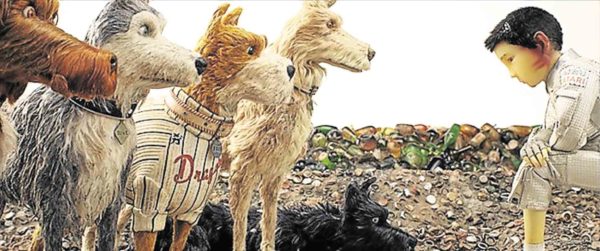A doggone convo with Wes
LOS ANGELES—I have a thing for Wes Anderson’s films. They are invariably sad yet beautiful, melancholic works of art that I, to honor his new film’s subjects, lap up. Some may find his movies boring or even tedious but I enjoy them all, from “The Royal Tenenbaums” to “The Grand Budapest Hotel.”
Wes’ latest triumph, “Isle of Dogs,” is bleak, set 20 years into the future in Japan where a mayor has banished dogs to a trash island. But it’s a stop-motion animation masterpiece—a poignant tale of a boy searching for his lost dog. The filmmaker’s eccentric aesthetic sets this film different from other animation films. It’s his second stop-motion animation work after “Fantastic Mr. Fox.”
An impressive roster of American and Japanese actors voice and give life to canine and human characters: Bryan Cranston, Koyu Rankin, Bill Murray, Edward Norton, Jeff Goldblum, Frances McDormand, Kunichi Nomura, Scarlett Johansson, Akira Ito, Harvey Keitel, F. Murray Abraham, Bob Balaban and Yoko Ono (yes, the Yoko Ono).
With a film populated mostly by an array of colorful, distinct canine characters, my chat with Wes went to the dogs, quite literally and in a good way.
What was your childhood relationship with dogs? There’s a dog in the movie named Chief (voiced by Bryan Cranston). That’s based on our dog when my brothers and I were kids. But to me, once we started writing the script, the dogs became more like people to us. And that was how we approached them as characters.
Article continues after this advertisementThey are the experiences of dogs but as soon as they are talking, they become humans. Especially once these actors started bringing them to life, they took over the roles completely.
Article continues after this advertisementCan you talk some more about your dogs when you were a kid? Chief was my older brother’s dog. That dog was a Labrador Retriever. He got big and outgrew our family. He went to live on a farm, and we lost him. I have another dog that was a Springer Spaniel. That was my dog.
We had some other attempts, but I feel like our family—we weren’t always able to care for dogs properly.
What animals do you have now? We have two goats (laughs), Hazelnut and Mexico. They belong to my daughter. They are Pygmy goats; they are tiny.
So your next movie could be about goats? It could be (laughs).
How did you get all these talented actors to do the voices? When you are doing an animated movie, you say to the actors, “Can you give me a few hours once? Maybe there’ll be some other line later …” If it’s someone you know, it’s difficult for them to say no. They can’t hide. The only reason they’d say no is because they don’t want to be in the movie. You have to be very blunt to do that. So with this one, we got everybody we wanted.
But I didn’t think of them before we wrote the film. It was just the kind of movie where everybody we asked said yes. Usually, there is a process of rejection that you begin with.
Bill Murray is noted for being hard to contact. How do you reach him? Bill is interesting because I know how to reach Bill. But that doesn’t mean I can reach Bill. I think he would probably always know that I was trying to find him, but that doesn’t mean that I will. But the one thing I will say that has really been my own good fortune over the years is, when we do these movies, he has always been there. He has always said yes.
Bill doesn’t need to spend a great deal of time promoting this film. It’s up to me, really. But he does it. He has been so encouraging. I think he feels good about helping (promote) because he feels good about the work. But I do feel like on a movie like this, he has really been so generous. I really owe a great debt to him.
Is the casting process different when you are just listening to the actors’ voices? Yes. You do sometimes close your eyes and listen to actors who you know very well. Sometimes just to think, does this person sound like this character, because it’s a much higher pitch than this person, than I imagine when I am looking at them. But a lot of them were people whom I have worked with before.
The key thing was this boy we found, Koyu Rankin. That was the key to the movie, in a way. Bryan has this very big role but Koyu has a crucial role because he is really the hero. He was only 8 when we cast him and his character is 12. He is still not 12. He is only 11.
But he has a great voice. He really did something that was surprising for us. It’s almost all in Japanese, so I don’t understand what he was saying (laughs). I just got the emotion.
In animation, actors usually record their voices separately. Were there times when you were able to record the actors together? Because the dogs sounded like they were having conversations. The group of dogs voiced by Bryan Cranston, Bill Murray, Jeff Goldblum, Bob Balaban and Edward Norton—we recorded them together because they are talking at the same time half of the time. That was really where we started. We recorded them.
Did Japanese mythology inspire this film? For me, more than Japanese mythology, we really thought about Japanese cinema. And the older cultural form was the genre of woodblock prints, ukiyo-e. We looked at all these images at the Met (Metropolitan Museum of Art in New York), all these old prints that are in the collection of Japanese art. And there are wonderful things.
They became part of a catalogue of inspirations and they were just up on everybody’s (animators’) wall. We didn’t necessarily even imitate anything. We just had them with us and somehow, they were finding their way in. And the ’50s and ’60s Kurosawa movies, that was a big thing for us. And also Miyazaki, we talked all the time about his work as we made the movie.
And the political aspect of the film? The politics—it began as kind of thinking about 20th-century Europe. But as we were making the movie, it was strange that what we were doing seemed to be happening on the front pages of newspapers. Not just in one place, but all over the world, really.
Do you keep some of the sets and items in your films? Yes. For years, I have been archiving things we make for the movies because we usually do have a lot of paintings, drawings or art. And all kinds of props. With a movie like this, everything is a prop. I mean, everything is an object that you can take home. It started to cross a threshold and I have so much stuff from this movie. I’m not sure what’s going to happen. I don’t have the space to keep this volume of stuff. It’s too much.
E-mail the columnist at [email protected]. Follow him at https://twitter.com/nepalesruben.

